MDS Computational Linguistics
UBC’s Master of Data Science in Computational Linguistics is the credential to set you apart. Offered at the Vancouver campus, this unique degree is tailored to those with a passion for language and data. Over 10 months, the program combines foundational data science courses with advanced computational linguistics courses, like natural language processing (NLP), equipping graduates with the skills to turn language-related data into knowledge and to build AI that can interpret human language.
For information on the MDS Computational Linguistics program, please go here.
Are you passionate about language?

Are you passionate about language and curious about data? UBC’s Master of Data Science in Computational Linguistics specialization was designed for you. An accelerated, 10-month, full-time program gets you into a career faster.
Program Benefits
Highlights Across All MDS Programs:
- 10-month, full-time, accelerated program offers a short-term commitment for long-term gain
- Condensed one-credit courses allow for in-depth focus on a limited set of topics at one time
- Capstone project gives students an opportunity to apply their skills
- Real-world data sets are integrated in all courses to provide practical experience across a range of domains
Highlights Specific To Computational Linguistics:
- Courses are taught by a combination of arts (linguistics), computer science, and statistics faculty members giving students access to key experts within each field of study
- Students learn fundamental data science skills, techniques, and tools with the core Master of Data Science cohort, then branch off into more specialized courses, such as natural language processing (NLP), experiencing the benefits of a large program and small program in one
- Students learn how to solve problems involving language data (i.e., text)
- Students learn how to use and build AI models including Large Language Models (LLMs), chatbots, Retrieval Augmented Generation (RAG) systems, and agentic workflows
- UBC’s Vancouver campus offers students the unrivaled experience of a top 40 university, surrounded by remarkable natural beauty, at the edge of a cosmopolitan city
- Strong connections with industry partners in public and private sectors, start-ups, and leading tech companies offer a wide range of networking/career opportunities

MDS Computational Linguistics Frequently Asked Questions - Admissions
In this video, Garrett Nicolai, Director and Assistant Professor of Teaching, for the UBC Master of Data Science (MDS) Computational Linguistics program, answers the most frequently asked question about the admissions process for the MDS Computational Linguistics program.

MDS Computational Linguistics Frequently Asked Questions - Program
In this video, Garrett Nicolai, Director and Assistant Professor of Teaching, for the UBC Master of Data Science (MDS) Computational Linguistics program, answers the most frequently asked question about the MDS Computational Linguistics program.
Curriculum*
The program structure includes 24 one-credit courses offered in four-week segments. Courses are lab-oriented and delivered in-person with some blended online content.
At the end of the six segments, an eight-week, six-credit capstone project is also included, allowing students to apply their newly acquired knowledge, while working alongside other students with real-life data sets. Please note that instructors are subject to change.
* subject to change at the discretion of the MDS Computational Linguistics program
Fall: September - December
Block 1 (4 weeks, 4 credits)
Programming for Data Science | DSCI 511
Program design and data manipulation with Python. Overview of data structures, iteration, flow control, and program design relevant to data exploration and analysis. When and how to exploit pre-existing libraries.
Muhammad Abdul-Mageed
Computing Platforms for Data Science | DSCI 521
How to install, maintain, and use the data scientific software stack. The Unix shell, version control, and problem solving strategies. Literate programming documents.
Ilya Musabirov (Section 1), Daniel Chen (Section 2)
Programming for Data Manipulation | DSCI 523
Program design and data manipulation with R. Organizing, filtering, sorting, grouping, reformatting, converting, and cleaning data to prepare it for further analysis.
Payman Nickchi (Section 1), Gittu George (Section 2)
Descriptive Statistics and Probability for Data Science | DSCI 551
Fundamental concepts in probability including conditional, joint, and marginal distributions. Statistical view of data coming from a probability distribution.
Andy Tai (Section 1), Alexi Rodriguez-Arelis (Section 2)
Block 2 (4 weeks, 4 credits)
Algorithms & Data Structures | DSCI 512
How to choose and use appropriate algorithms and data structures to help solve data science problems. Key concepts such as recursion and algorithmic complexity (e.g., efficiency, scalability).
Muhammad Abdul-Mageed
Data Visualization I | DSCI 531
Exploratory data analysis. Design of effective static visualizations. Plotting tools in R and Python.
Payman Nickchi (Section 1), Andy Tai (Section 2)
Statistical Inference and Computation I | DSCI 552
The statistical and probabilistic foundations of inference. Large sample results. The frequentist paradigm.
Katie Burak (Section 1), Rodolfo Lourenzutti (Section 2)
Supervised Learning I | DSCI 571
Introduction to supervised machine learning. Basic machine learning concepts such as generalization error and overfitting. Various approaches such as K-NN, decision trees, linear classifiers.
Prajeet Bajpai (Section 1), Varada Kolhatka (Section 2)
Block 3 (4 weeks, 4 credits)
Corpus Linguistics | COLX 521
Basic processing of text corpora using Python. Includes string manipulation, corpus readers, linguistic comparison of corpora, structured text formats, and text preprocessing tools.
Garrett Nicolai
Databases & Data Retrieval | DSCI 513
How to work with data stored in relational database systems. Storage structures and schemas, data relationships, and ways to query and aggregate such data.
Hedayat Zarkoob (Section 1), Andy Tai (Section 2), Gittu George (Section 2)
Regression I | DSCI 561
Linear models for a quantitative response variable, with multiple categorical and/or quantitative predictors. Matrix formulation of linear regression. Model assessment and prediction.
Katie Burak (Section 1), Rodolfo Lourenzutti (Section 2)
Feature and Model Selection | DSCI 573
How to evaluate and select features and models. Cross-validation, ROC curves, feature engineering, and regularization.
Elham E Khoda (Section 1), Prajeet Bajpai (Section 2)
Winter: January - April
Block 4 (4 weeks, 4 credits)
Parsing for Computational Linguistics | COLX 535
The identification of syntactic structure in natural language. Parsing algorithms for popular grammar formalisms, application of statistical information to parsing, parser evaluation, and extraction of parse features.
Garrett Nicolai
Computational Semantics | COLX 561
How meaning is represented by computers. An overview of popular semantic resources, and techniques for building new resources from unstructured text data.
Isabel Papadimitriou
Unsupervised Learning | DSCI 563
How to find groups and other structure in unlabeled, possibly high dimensional data. Dimension reduction for visualization and data analysis. Clustering, association rules, model fitting via the EM algorithm and Large Language Models (LLMs).
Jian Zhu
Supervised Learning II | DSCI 572
Introduction to optimization. Gradient descent and stochastic gradient descent. Roundoff error and finite differences. Neural networks and deep learning.
Jian Zhu
Block 5 (4 weeks + 1 week break, 4 credits)
Advanced Corpus Linguistics | COLX 523
Text corpora collection and curation. How to pull representative datasets from internet sources. Techniques for efficient and reliable annotation.
Garrett Nicolai
Computational Morphology | COLX 525
Approaches to sub-word phenomenon in language processing. Automatic morphological analysis of diverse languages, part of speech tagging, word segmentation, and character-level neural network models.
Garrett Nicolai
Machine Translation | COLX 531
Key methodologies for automatic translation between languages, with a focus on statistical and neural machine translation approaches. Applying Machine Translation (MT) architectures to analogous monolingual tasks. MT evaluation.
Jian Zhu
Sentiment Analysis | COLX 565
Identification and analysis of opinion, especially in social media. Text polarity and emotion classification, fine-grained (e.g. aspectual) opinion mining, argumentation mining, agentic workflows, and sentiment in social networks.
Isabel Papadimitriou
Block 6 (4 weeks, 4 credits)
Advanced Computational Semantics | COLX 563
Application of machine learning to various semantic tasks. Likely topics include: information extraction, semantic role labelling, semantic parsing, discourse parsing, question answering, summarization, retrieval augmented generation (RAG), and natural language inference.
Isabel Papadimitriou
Natural Language Processing for Low-Resource Languages | COLX 581
Building automatic language tools when data is scarce. Rule-based and hybrid systems, semi-supervised learning, active learning. Knowledge transfer from other (related) languages.
Garrett Nicolai
Trends in Computational Linguistics | COLX 585
Cutting-edge techniques in natural language processing. For this iteration, the latest innovations in neural network architectures including artificial intelligence (AI).
Jian Zhu
Privacy, Ethics & Security | DSCI 541
The legal, ethical, and security issues concerning data, including aggregated data. Proactive compliance with rules and, in their absence, principles for the responsible management of sensitive data. Case studies.
Isabel Papadimitriou
Spring: May - June
Capstone Project (8-10 Weeks, 6 credits)
Capstone Project | COLX 595
A mentored group project based on real data and questions from a partner within or outside the university. Students will formulate questions and design and execute a suitable analysis plan. The group will work collaboratively to produce a project report, presentation, and possibly other products, such as a web application.
MDS Computational Linguistics Staff
Meet Amy

Even though Amy found the MDS Computational Linguistics program an intensive and accelerated one, it actually better fit her needs. Amy felt the most important thing they learned is to solve problems and once you are able to see a clear picture of the data, you are able to feel a sense of achievement.
